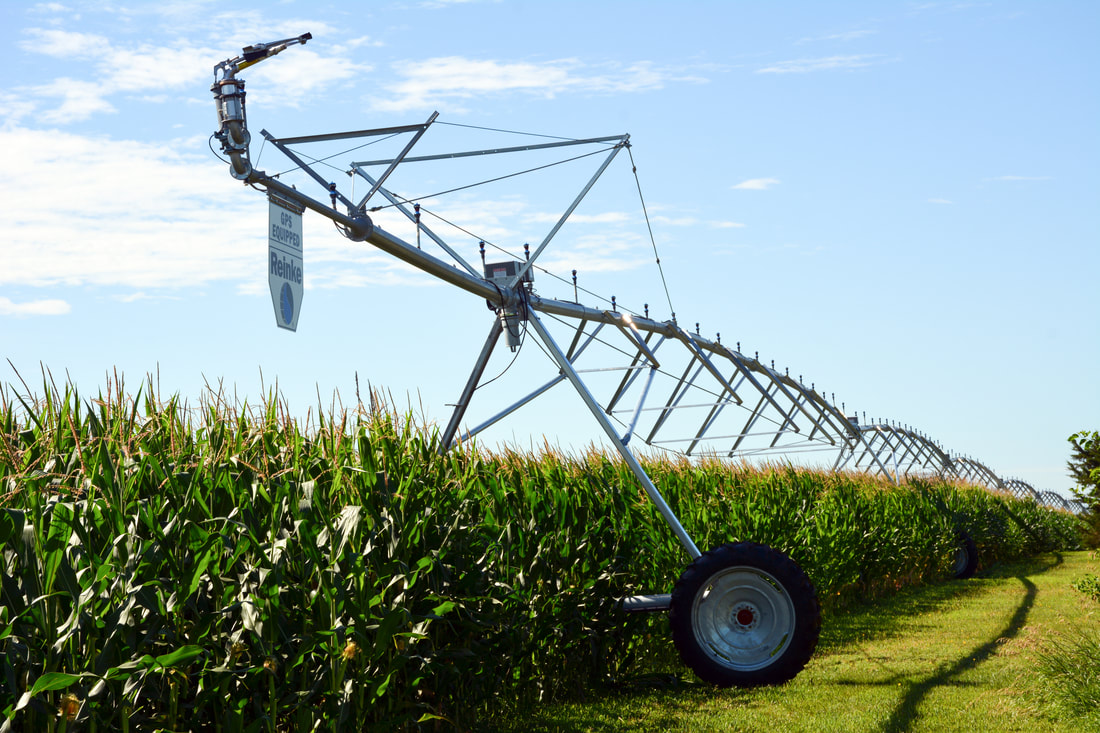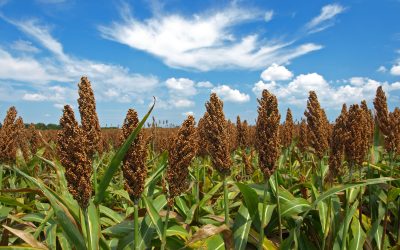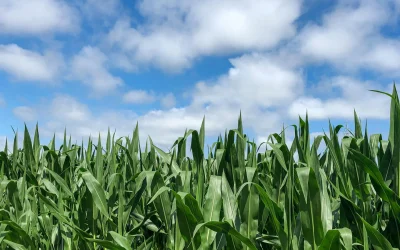Key Takeaways
- Efficient irrigation is critical to maximizing corn yield and grain quality while conserving water.
- Corn requires 20–30 inches of water annually, with peak demand at tasseling during early reproductive stages.
- Both water shortages and excess moisture can negatively impact corn development and yield.
- Soil type, weather, crop stage and hybrid genetics influence irrigation timing and frequency.
- Evapotranspiration (ET) is a valuable tool for estimating crop water use and guiding irrigation decisions.
- Maximum allowable depletion (MAD) helps determine when to irrigate based on available soil moisture.
- Irrigation innovations like TerraFlow® have demonstrated improved yield and water savings for corn farmers.
Farmers have been irrigating crops since production agriculture began in the U.S. As early as the mid-1800s, growers began diverting surface waters to support their crops in response to uncertain rainfall and high crop moisture demands.1 Today, irrigation remains a critical management practice for corn growers across the U.S. Let’s explore the importance of efficient water management in corn and ways irrigation supports crop productivity and farm profitability.
Importance of Water in Corn Growth
Water needs can vary by hybrid and region. While many full-season corn hybrids require 20–30 inches of water annually, shorter-season hybrids in cooler or more northern regions may require less. Still, regardless of variety, consistent moisture during key growth stages remains critical for achieving target yields. Lack of sufficient moisture during the crop’s vegetative stages can lead to reduced root growth and leaf surface area, fewer kernel rows and stunted plants. Water-stressed plants in reproductive stages have reduced pollination efficiency and kernel set. During grain fill, drought stress can cause premature plant death, smaller kernels and kernel abortion, ultimately leading to lower corn yield and grain quality.
While insufficient moisture is certainly a yield threat, too much water is also a problem for the corn crop. Excessive moisture can lead to nutrient leaching, poor root growth and a higher risk for plant diseases. Timely and well-managed irrigation can help ensure the crop has the right amount of moisture during critical development stages to optimize corn yield and quality potential.
Factors Influencing Water Needs
Developing an irrigation strategy is a fluid process that must adapt to the crop’s needs. Some factors that influence a corn crop’s moisture requirements include:
- soil type
- weather conditions
- crop growth stage
- hybrid genetics and yield potential
Soil texture affects water retention and drainage, impacting the amount of plant-available water and irrigation frequency. Climate variables like temperature, humidity and rainfall patterns also influence water requirements. The corn crop also has different moisture needs depending on the growth stage. To optimize the corn irrigation strategy, you’ll need to consider all these factors in your watering schedule.
Water Use Patterns by Growth Stage
The graph below highlights a corn crop’s water use throughout the season. Minimal water is required at the beginning and end of the crop’s development. As the plant grows rapidly in the vegetative stage, it adds more leaves and transpiration increases. Peak water use in corn occurs at the beginning of the reproductive stage at tasseling, when the crop requires more than 0.3 inches per day to meet developmental needs. Because water use peaks during tasseling, farmers are looking for ways to improve water delivery and retention at this stage. This includes strategies like precision scheduling, sensor-based irrigation and enhanced water treatment technologies like TerraFlow®.
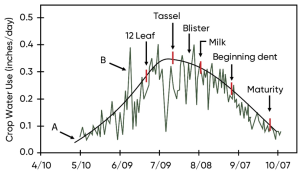
Evapotranspiration (ET)
Evapotranspiration (ET) is a term used to describe water loss from evaporation and plant transpiration. When plants take up water from the soil, it’s transported throughout plant tissues and eventually released through the stomata back into the atmosphere as water vapor. This process is transpiration. However, water is also lost when it evaporates from plant leaves and the soil. Evapotranspiration considers both processes and can be used to estimate the crop system’s total water loss from plant transpiration and evaporation.
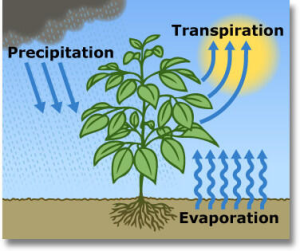
Source: United States Geological Survey
Evapotranspiration rates are influenced by many variables, including:
- air temperature
- solar radiation
- the crop’s growth stage
- soil type
- relative humidity
- wind speed
Understanding a crop’s evapotranspiration rate can help optimize irrigation management.
Determining Irrigation Timing and Amount
Farmers take many approaches to determine irrigation timing. According to the USDA’s 2023 Irrigation and Water Management Survey, nearly 75% of surveyed farmers use the crop’s condition to decide when to irrigate. Other popular methods included feeling the soil (touch method), following their water suppliers’ recommended schedule and using soil moisture sensing devices.4
Each method has benefits and limitations, so farmers may use information from several sources to guide more precise irrigation scheduling. Soil moisture sensors can provide real-time information for the most accurate moisture estimates across a field. However, it’s also a good practice to scout crops early and often to identify signs of drought stress in corn. Early drought stress may appear as rolled leaves and slow growth. More severe drought stress may cause leaf wilting, stunted plants and burning at the leaf edges.
For most crops, a plant starts to experience water stress when 30% to 70% of the plant-available water in the soil has been depleted. Maximum allowable depletion (MAD) is the percentage of plant-available water the soil can reach before a plant becomes stressed and irrigation is required. For corn, 50% MAD is commonly used to guide irrigation events. Let’s look at a simple calculation to understand how farmers can use MAD to guide corn irrigation.
Managing Irrigation Schedules Using MAD Percentage
Scenario: A farmer is irrigating corn at the blister stage in a silty clay soil. When should water be applied to avoid plant stress?
Assumed information:
- Corn root depth at the blister stage is 3.5 ft.
- The water holding capacity of a silty clay soil is 1.6 in/ft.
- At 3.5 ft., a silty clay soil has a water holding capacity of 5.6 inches (3.5 * 1.6 = 5.6)
Irrigation calculations:
- Corn can only use 50% of the total water holding capacity before plant stress begins. Therefore, MAD = 2.8 inches. (5.6/2=2.8)
- To maximize plant health, irrigation should be applied before the soil has 2.8 inches of plant-available water.
While this calculation gives the farmer an estimate of when to apply water based on soil moisture availability, it doesn’t tell us exactly when the soil will reach MAD. That will depend on the local environmental conditions and evapotranspiration rate. For the scenario above, if we assume the ET rate is 0.4 inches per day and the MAD is 2.8 inches, there should be enough stored water in the soil to meet the corn plant’s needs for seven days.
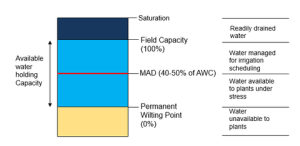
Source: University of Minnesota
Corn Irrigation Systems & Methods
The most common irrigation systems used in corn production are center-pivot, subsurface and furrow. Each method offers benefits and limitations, and finding the most efficient irrigation system will depend on farm size, topography, water source and budget.
Center pivot
Center pivot is the most common irrigation method in corn, primarily because it can cover many acres cost-effectively. Center pivot irrigation is compatible with various land types, but may not be the best fit for irregularly shaped fields.
Subsurface
Subsurface irrigation is more expensive to install and manage than other corn irrigation systems, but it is a good investment in areas with limited water resources. Subsurface irrigation is more efficient than center pivot or furrow irrigation because water is distributed directly in the root zone, limiting water loss risks.
Furrow
Furrow irrigation is less common than center pivot or subsurface irrigation, but it is a good option for sandy soils with a lower water-holding capacity. It is an affordable option when a reliable water source is available and is often used in flat valleys, such as those in Western Nebraska.
Innovations in Corn Irrigation
Water availability is a significant limitation for many corn growers across the country. Water conservation in food production is becoming a hot topic in agriculture as temperatures continue to rise. Maximizing irrigation efficiency is one way you can meet production goals while conserving valuable water resources. Farmers are adopting some of these irrigation technologies to get more from every drop.
Smart Irrigation Systems
Precision irrigation is gaining popularity as it allows farmers to fine-tune application timing and amounts across different application zones. Drones, weather models and soil moisture sensors supply data that can more accurately predict a crop’s water needs throughout the season. Using this information, precision watering schedules can be created and updated as the season progresses.
A 2023 study supported by the U.S. Department of Agriculture’s Natural Resources Conservation Service (NRCS) and conducted by the Michigan State University Irrigation Lab demonstrates the benefits of smart irrigation sensor technology. The study found that the technology saved 1.9 inches of applied irrigation water in a commercial corn field while maintaining the same or even higher yields compared to the farmer’s existing irrigation practices, which relied on crop condition and soil feel tests. This data indicates that by adopting smart irrigation sensor technology, it could be possible to conserve up to 29 billion gallons of freshwater from irrigated corn and soybean fields in Michigan. This amount represents about 23% of the state’s total agricultural water use.6
Chemigation
Chemigation refers to applying crop protection products and fertilizers via the irrigation system. Modern irrigation systems enable chemigation using sophisticated equipment and software programs. Chemigation allows farmers to spoon-feed crops as they apply water, enabling more precise product placement. Chemigation may also help reduce the amount of fertilizers and other chemicals used, saving on input and application costs.
Water Enhancement Technology
One of the newest innovations in irrigation technology is water enhancement. UpTerra is helping farmers do more with less by optimizing their irrigation water with TerraFlow®. TerraFlow is a plug-and-play device that is compatible with most irrigation systems. It uses patent-pending vortexing and frequency transmission technologies to energize and enhance irrigation water so it is more hydrating for plants and the soil.
With TerraFlow, water spreads across and into the soil profile more evenly, contributing to better water availability and retention. More consistent moisture distribution has many positive agronomic impacts, including better nutrient uptake, more microbial activity in the root zone, less plant stress and healthier soils. Over time, these benefits are cumulative, helping growers grow more with fewer inputs.
TerraFlow helped corn farmers achieve these results:*
- A 10.8% yield increase using 10% less fertilizer (Oklahoma farm)
- An 8.5% corn silage increase with nearly 20% less water (Texas farm)
- A 16.8% yield increase, resulting in $72/acre in additional income (Kansas farm)
- An 18-20% available water increase in the soil (Kansas farm)
Cultivating Success Through Smarter Irrigation
As stewards of the land, today’s corn farmers face increasing pressure to produce more with less—less water, fewer inputs and narrower profit margins. But the path forward doesn’t have to mean compromise. By understanding the crop’s growth stages, leveraging evapotranspiration data and using innovative tools like soil moisture sensors and water enhancement technologies, farmers can create irrigation strategies that are as precise as they are productive.
Efficient irrigation isn’t just about applying water—it’s about collecting and applying knowledge. It’s about knowing when, where and how much water a corn crop needs to thrive. Whether fine-tuning a center pivot system or integrating smart irrigation and chemigation practices, each step toward better water management is an investment in crop health, yield potential and a long-term legacy.
Optimizing corn irrigation means growing smarter. And with the right approach, you’re not just conserving a precious resource—you’re building a more resilient, profitable farm for the seasons ahead. At UpTerra, we’re always looking for ways to help farmers get more from every drop. If you’re interested in exploring how enhanced water technologies could support your irrigation goals, we’d love to talk.
* Results based on field trials conducted by UpTerra with partner farms comparing fields treated with TerraFlow irrigation water and untreated irrigation water.
References
1 Evett SR, Colaizzi PD, Lamm FR, et al. Past, Present, and Future of Irrigation on the U.S. Great Plains. Vol. 63(3): 703-729. 2020.
2 Kranz WL, Irmak S, van Donk SJ, et al. University of Nebraska Extension. Irrigation Management for Corn. 2008.
3 USGS. Evapotranspiration and the Water Cycle. 2018.
4 United States Department of Agriculture. 2023 Irrigation and Water Management Survey. 2024.
5 University of Minnesota. Basics of Irrigation Scheduling. 2019.
6 Michigan State University Extension. Improving Irrigation Efficiency and Annual Water Use Reporting. 2024.

